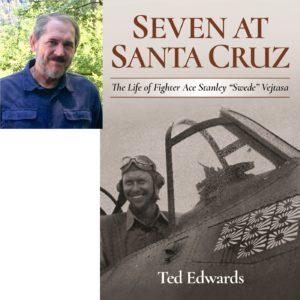Podcast: Play in new window | Download
Subscribe: RSS
 Ted Edwards grew up around WWII veterans and ended up studying history in college. He’s a mountaineer and involved with US Gymnastics and kept journals about his experiences. These varied interests resulted in a meeting with some famed WWII naval aviators and he ended up writing a book about one of them. I interviewed him about the new book.
Ted Edwards grew up around WWII veterans and ended up studying history in college. He’s a mountaineer and involved with US Gymnastics and kept journals about his experiences. These varied interests resulted in a meeting with some famed WWII naval aviators and he ended up writing a book about one of them. I interviewed him about the new book.
1:58 – Ted first discusses how he got into writing and history. He was born in 1945 and grew up around WWII veterans. He became fascinated with military history. He learned how to write history at Stonybrook.
4:31 – He took up journaling and did so when he did mountaineering and was involved with US gymnastics.
5:01 – He attended an event for men who had been on the USS Enterprise and he met a man who who flew on the Enterprise and wrote a book about it. Ted was then introduced to Swede and they spoke a while.
7:21 – Swede had done a lot on the Enterprise but none of the official accounts of his exploits matched. They then discussed what actually happened during his career. Swede then let Ted record and then write about Swede’s career. It was an 8 year endeavor.
10:02 – The book talks about the A-team, which were the first group of pilots who fought the Japanese after Pearl Harbor. The book also talks about leadership failures including those of Admiral Kincaid. There is also a discussion of Medal of Honor politics.
12:20 – Swede saw a report about one of his important missions that was supposed to have been written by him but he said he was certain he never wrote the report. Swede kept his own journal during his life.
15:31 – Swede went on missions right after Pearl Harbor and said that even a month later the devastation was apparent.
18:43 – Bill Birch, Swede’s old squadron commander, had taught Swede and fellow pilots a lot about dogfighting which helped him achieve success.
20:50 – He switched to fighters after success as a bomber pilot.
22:04 – The day before the battle of Santa Cruz might be more important than the battle itself. Swede’s group had a terrible patrol that made the battle that much more difficult.
23:36 – Swede was shocked when he heard that Admiral Kincaid was in charge of the carrier task force before Santa Cruz because Kincaid wasn’t an aviator.
25:17 – Kincaid creates a Wildcat strike group to go out 300 hundred plus miles and Swede objected because of the distance but they’re sent out.
27:08 – The patrol found nothing and returned late even though almost none of them was qualified for night landing. Then the Enterprise wasn’t where it was supposed to be and it was dark. They followed an oil slick to find the ship.
33:31 – The US rotated its veteran aviators to train young pilots whereas the Japanese used their best pilots until they died. Swede didn’t like being made an instructor but he did enjoy being an instructor once he started.
37:31 – He was made CO of the Constellation in the 1960s but there was a fatal accident that hurt his career. He took responsibility for it though.
40:31 – Ted interviewed a number of WWII naval aviators for the book.
45:09 – Swede told Ted about John Stapp who was studying the forces on pilots when they ejected from planes. John used a high speed spinning sled to test this and Swede was offered a ride and declined because John got beat up by the machine. John became famous for this and got seat belts mandated for cars.
51:01 – Ted had to learn the format that Naval Institute Press used for his books before he could finish it.
For more “Military History Inside Out” please follow me on Facebook at warscholar, on twitter at Warscholar, on youtube at warscholar1945 and on Instagram @crisalvarezswarscholar
Guests: Ted Edwards
Host: Cris Alvarez
Tags: military, history, military history, conflict, war, interview, non-fiction book, stonybrook, corsair, wildcat, enterprise, constellation, aviation accidents, torpedo bombers, dive bombers, combat air patrol
